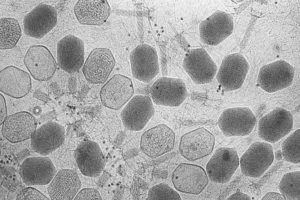by Luis Melecio-Zambrano

During the last few years, CRISPR has grabbed headlines for helping treat patients with conditions as varied as blindness and sickle cell disease. However, long before humans co-opted CRISPR to fight genetic disorders, bacteria were using CRISPR as an immune system to fight off viruses.
In bacteria, CRISPR (Clustered Regularly Interspaced Short Palindromic Repeats) works by stealing small pieces of DNA from infecting viruses and storing those chunks in the genes of the bacteria. These chunks of DNA, called spacers, are then copied to form little tags, which attach to proteins that float around until they find a matching piece of DNA. When they find a match, they recognize it as a virus and cut it up.
Now, a paper published in Current Biology by researchers from the University of Pennsylvania Department of Physics and Astronomy shows that the risk of autoimmunity plays a key role in shaping how CRISPR stores viral information, guiding how many spacers bacteria keep in their genes, and how long those spacers are.
Ideally, spacers should only match DNA belonging to the virus, but there is a small statistical chance that the spacer matches another chunk of DNA in the bacteria itself. That could spell death from an autoimmune response.
“The adaptive immune system in vertebrates can produce autoimmune disorders. They’re very serious and dangerous, but people hadn’t really considered that carefully for bacteria,” says Vijay Balasubramanian, principal investigator for the paper and the Cathy and Marc Lasry Professor of Physics in the School of Arts & Sciences.
Balancing this risk can put the bacteria in something of an evolutionary bind. Having more spacers means they can store more information and fend off more types of viruses, but it also increases the likelihood that one of the spacers might match the DNA in the bacteria and trigger an autoimmune response.
Read the full story in Penn Today.
Vijay Balasubramanian is the Cathy and Marc Lasry Professor of Physics at the Department of Physics and Astronomy of the University of Pennsylvania, a visiting professor at Vrije Universiteit Brussel, and a member of the Penn Bioengineering Graduate Group.
